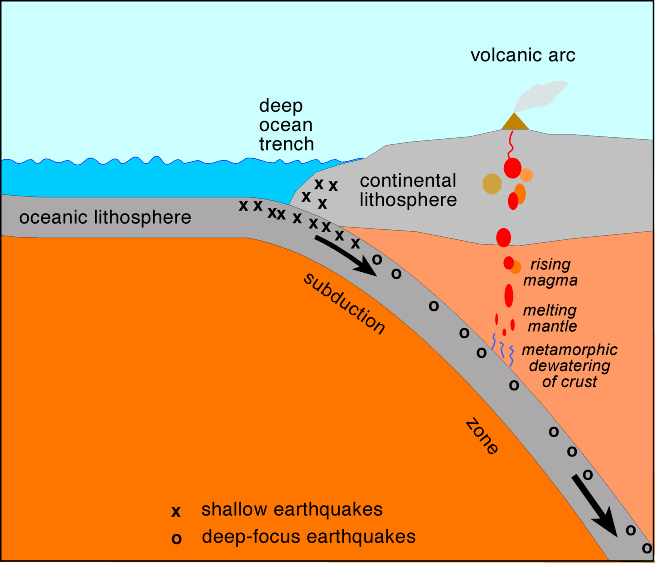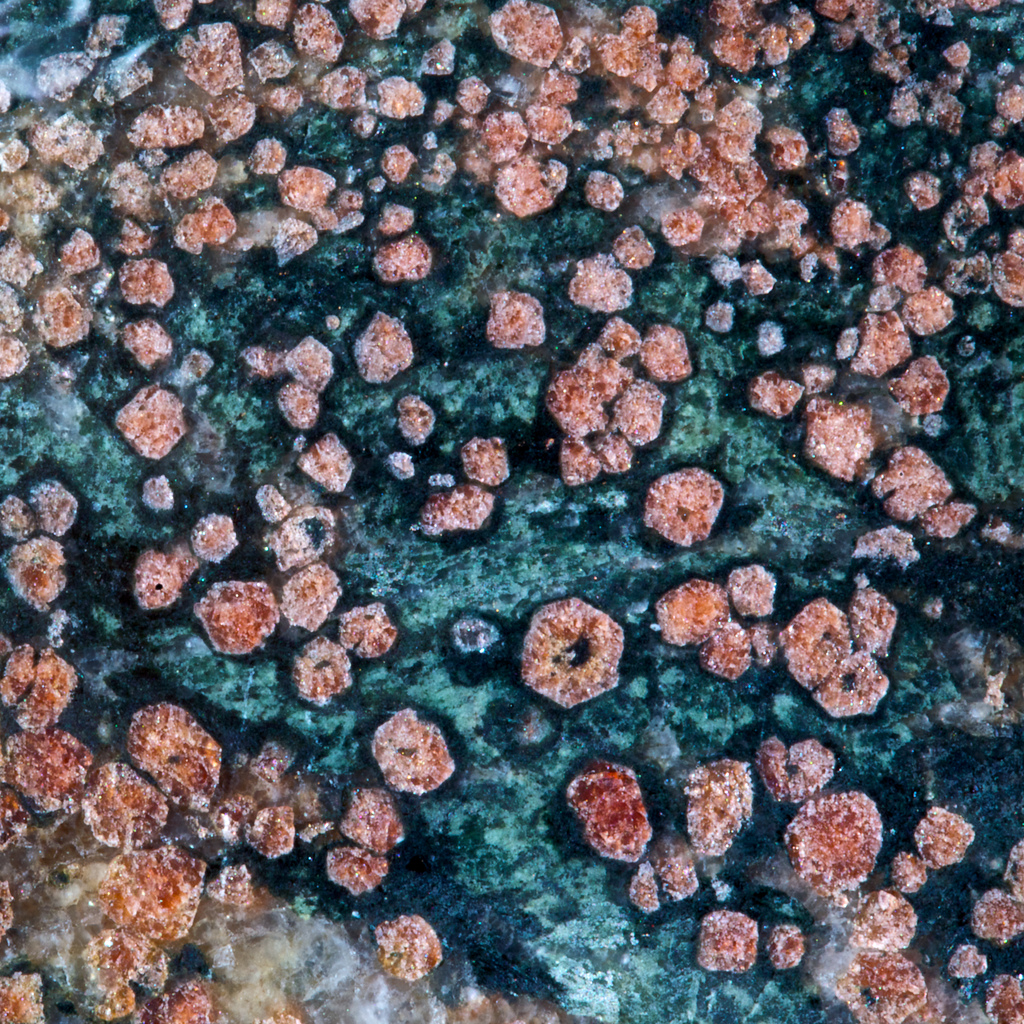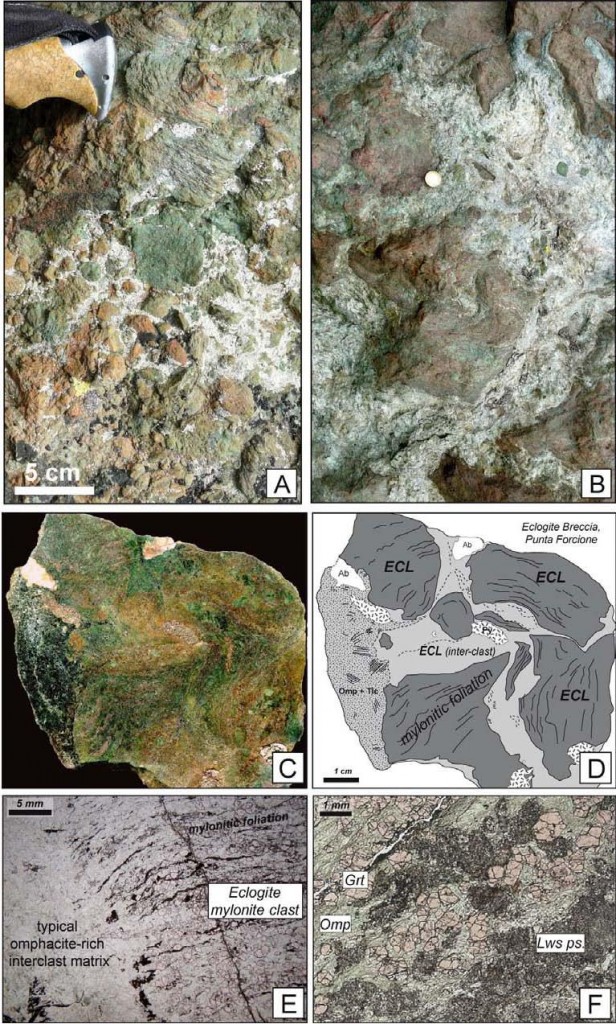Eclogites are beautiful rocks that form deep within subduction zones. The vast majority of subducted oceanic crust becomes more dense than the surrounding mantle rocks and travels to the strange world of the deep earth. Lucky for us, small volumes make it back to the surface. How does this happen? As so often in the Earth sciences, a combination of detailed field work, laboratory analysis and modelling yields many insights.

ZS Unit: valtournanche Garnet omphacite + late Gln rims around grt. All images in this post courtesy of Samuel Angiboust.
To the Alps
The Alps are a major mountain belt stretching across Europe. They are the result of the closure of the Tethys ocean which used to separate Africa and Europe. The details are complex – oceanic crust remains in the Mediterranean and there are small fragments of continental crust in the mix too. In the western Alps, stretching through Switzerland, Italy and into Corsica, there are large areas of oceanic crust (known as ophiolites). These ophiolites were subducted 50 million years ago and turned into eclogites. They now sit on the surface sandwiched between other less exotic metamorphic rocks, firmly part of the continental crust.
Very recently these rocks have been studied by Samuel Angiboust who (with others) has produced a series of papers. I’ve written about one before, concerning traces of ancient earthquakes. He’s kindly provided me with some photos, so I can give you a view of the rocks before I describe his other research.
Ophiolites are interesting as they allow us to study oceanic crust without getting our feet wet. These Alpine ophiolites have another added layer of interest – they have also been metamorphosed in complex ways. Here’s an example of what I mean. Ophiolites typically contain parts of the top layer of oceanic crust, ancient lava flows made of basalt that formed pillow shapes as it cooled underwater. Here are some from the Alps.
The structure is unremarkable – pillowed lobes with thin layers of sediment (radiolarian chert) in between. What is special is that this rock has been buried 70km under the surface. Every mineral grain in it has been recrystallised – nearly every atom in these rocks moved as the rock was utterly transformed under the new high pressure conditions. This movement of atoms is only on the millimetre scale (or less); the edge between sediment and basalt is still sharp. The rock is superficially the same yet utterly transformed.
There is no obvious sign of deformation in this outcrop either, despite them being shoved down into the earth and pulled back out again. Much of the ophiolite is extremely deformed, but little patches of calm often remain even among the most tormented rocks.
Slabs or Knockers?
How do high-pressure rocks get to the surface? One possibility is that eclogite rocks are broken into fragments and somehow squeezed to the surface as tectonic blocks. Some models of subduction zones include a channel of soft serpentinite immediately above the subducting plate. In such a ‘mélange’ rigid pips of eclogite may be squeezed towards the surface. Such things do happen: accretionary wedges, the piles of sediment that form above subduction zones, often contain ‘knockers’* of high-grade rock (including eclogite).
Is this how our Alpine rocks got back up? How could we tell? Angiboust and colleagues look at the record of metamorphism. There are large joined up areas of eclogite, cross-cut by serpentinite shear-zones. If the eclogite came up as pips then each pip would have a different metamorphic history and have reached different depths in the subduction zone.
Metamorphism
In a 2011 paper, available for free Angiboust and others summarise a mass of data from the Monviso Ophiolite, found along the French-Italian border. They found a wide range of metamorphosed rock types, from limy muds (now calc-schists), mudstones (now metapelite) to meta-basalt and meta-gabbro. This allowed them to apply a wide range of techniques to estimate to conditions under which these rocks were metamorphosed.
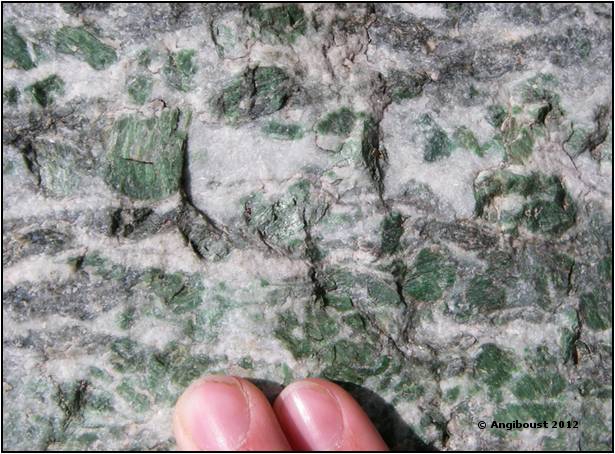
Eclogite facies Mg-Al metagabbro, Monviso ophiolite. Green patches are Cr-rich pyroxene (omphacite).
Metamorphic petrology relies on the fact that changing conditions of temperature and pressure transform the minerals present in rocks in predictable ways. Our authors used THERMOCALC, which combines our knowledge of the thermodynamic properties of rock-forming minerals with analysis of the composition of a rock sample and its minerals to estimate to conditions under which those minerals formed. (For more details on what that sentence means, see my posts on metamorphism).
A technique new to me was Raman Spectroscopy of Carbonaceous Matter (RSCM) that analyses the degree to which carbonaceous material (boiled up fossils) has been converted to graphite. The conversion to graphite depends only on the maximum temperature reached – unlike most other ways of estimating peak metamorphic conditions, it can’t be reset and doesn’t depend on pressure. Very neat.
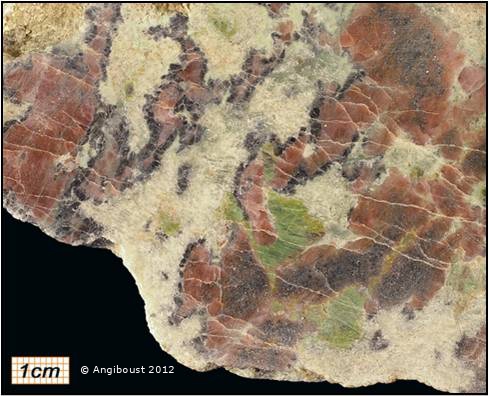
Eclogite facies Mg-Al metatroctolite, Monviso Dark chloritoid, green omphacite, pink garnet, white talc (where olivine was. See Messiga et al JMG 1999).
The point of all this painstaking work is to estimate the most extreme conditions reached by these rocks, to discover how deep they reached. By studying over 60 rock samples they were able to distinguish two domains, within which the peak metamorphic conditions were extremely consistent. The deeper Lago Superiore Unit reached conditions of 530–550°C and 26–27.5 kbar, corresponding to burial to 80 km depth. All of this unit reached the same depth, suggesting it hasn’t been broken up since – this is no pip, but a large slab of rock (20–30 km-long, 2–3 km thick) that “corresponds to a more or less preserved portion of thinned oceanic crust detached from 80 km depth in the Alpine subduction zone“.
If this is the case, then how did it get back up to the surface? One reason might be that it was quite wet.

Hydrothermally altered eclogite (Aosta Valley, Italy, Zermatt Saas Unit) With garnet, chloritoid (black), talc (whitish). Enrichment in Fe-Mg (+ pyrite) Due to seafloor hydrothermal alteration led to this very unusual Paragenesis (sample Angiboust, photo Marco Moroni, UPMC). This rock sample belongs to a fossilized hydrothermal system. Fossilized eclogitized “black smokers” can be occasionally seen on the field in Aosta valley (see Martin et al., 2008)
The role of water
In another recent paper, Angiboust and others discuss the influence of water in eclogites. As newly created oceanic crust cools it can take up a lot of water from the overlying ocean. This is bound up within minerals and so is taken down into the subduction zone. Looking at the Zermatt–Saas ophiolite (Switzerland/Italy) they identify portions of oceanic crust that were extensively affected by hydrothermal processes, perhaps because they formed at a slow-spreading ocean ridge. Now eclogitised, these have between 2.5 and 6% H2O (by weight) which is unusually high. Eclogites more usually have between 0 and 1 %.
All this water affects the minerals that are stable under eclogite facies conditions. Glaucophane is the mineral that puts the blue in blueschist facies – it’s normally stable only under lower pressures. In these ‘wet’ eclogite rocks it remains stable.
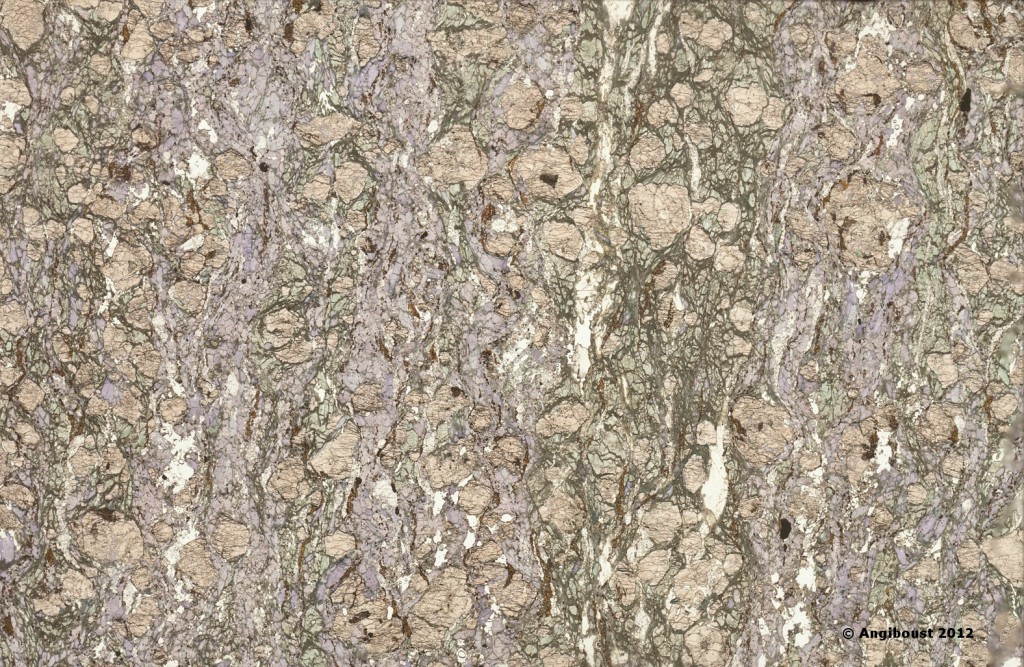
ZS Unit Aosta valley, glaucophane bearing eclogite (scanned thin section 50x30mm) showing that glaucophane may be stable under eclogite facies, together with omphcite + grt + rutile.
Lawsonite and phengite are other water-bearing minerals stable in these rocks. All of these water-bearing minerals are significantly less dense than more typical eclogite minerals such as garnet and omphacite. Based on detailed analysis, our authors estimate that these hydrothermally altered rocks are 5-10% less dense than normal eclogite. These are crustal rocks – the mantle rocks beneath were also pumped full of water turning them into serpentinite. Serpentinite is olivine plus water and about 15% lighter than ‘dry’ mantle rocks.
So overall, hydrated oceanic lithosphere is lower density than both ‘normal’ lithosphere and the surrounding mantle rocks. This keeps it buoyant. This is important as these rocks nearly reached the depth at which normal eclogite becomes denser than the surrounding mantle, at which point subduction becomes irreversible. In these ‘wetter’ rocks low-density hydrated minerals remain stable at higher pressures, so the entire slab is harder to subduct.
Back to the surface
A clue to how these Alpine Ophiolites got back out of the subduction zone comes from the wider geological context. They are now stacked up alongside continental rocks that also reached high pressures. Soon after our ophiolites were subducted the ocean basin closed and continental crust starting being stuffed down into the subduction zone, reaching depths of 80km. This continental subduction became an unstable situation, as continental crust is much less dense than oceanic material. Subduction stopped and the deeply buried rocks were rapidly exhumed, making their way back to the surface.

Diagram showing sequence of actions leading to ophiolite slices returning being attached to buoyant continental crust.
Our authors propose a two-stage process. Firstly our ophiolite slices became detached from the sinking oceanic plate. The plate was not smooth and had variable thickness, making this mechanically plausible . They see the detachment being associated with large earthquakes, that would have created tsunami washing across the shores of the Tethyan ocean basin. The next stage is where the thin leading edge of the continental crust is thrust underneath our ophiolite slices. This mixed buoyant material then rapidly returns to the surface, bringing the ophiolite up with it.
This mechanism is a little elaborate, with many particular circumstances being required. However the authors emphasize that the preservation and exhumation of such a big fragment of oceanic lithosphere would have been possible without the mechanical intervention of underlying, buoyant continental crust. That’s why Alpine ophiolitic rocks (and involved volumes) are so unique to understand the steady-state processes potentially occurring at depth in active subduction zones. In his current research, Angiboust is finding evidence for similar large tectonic slices within eclogitic ophiolites in Iran.
The overwhelming majority of subducted oceanic crust is lost forever into the mantle. The story of how eclogites avoid this fate is fascinating and surely not yet fully understood. I’m sure the study of these beautiful rocks will yield more surprises in the future.
*Clearly these weren’t named by an English person, who whom the term ‘knockers’ would have other connotations….
Many thanks to Samuel Angiboust, for the pictures and for providing useful feedback.
References
Angiboust, S., & Agard, P. (2010). Initial water budget: The key to detaching large volumes of eclogitized oceanic crust along the subduction channel? Lithos, 120 (3-4), 453-474 DOI: 10.1016/j.lithos.2010.09.007
Angiboust, S.,, Agard, P.,, Raimbourg, H.,, Yamato, P.,, & Huet, B. (2011). Subduction interface processes recorded by eclogite-facies shear zones (Monviso, W. Alps) Lithos DOI: dx..org/10.1016/j.lithos.2011.09.004
Silvana Martin, Gisella Rebay, Jean-Robert Kienast, & Catherine Mével (2008). AN ECLOGITISED OCEANIC PALAEO-HYDROTHERMAL FIELD FROM THE ST. MARCEL VALLEY (ITALIAN WESTERN ALPS) Ofioliti : doi:10.4454/ofioliti.v33i1.359
MESSIGA, KIENAST, REBAY, RICCARDI, & TRIBUZIO, . (2001). Cr-rich magnesiochloritoid eclogites from the Monviso ophiolites (Western Alps, Italy) Journal of Metamorphic Geology, 17 (3), 287-299 DOI: 10.1046/j.1525-1314.1999.00198.x







